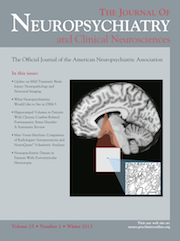Using Paliperidone as a Monotherapeutic Agent on a Schizophrenic Patient With Cirrhosis of the Liver
To the Editor: Liver cirrhosis may cause hepatic encephalopathy, which includes a complicated cluster of neurological symptoms. Confusion, irritability, disorganized speech and behavior, and conscious disturbance are not uncommon in this situation.1 When a schizophrenic patient has comorbidity of liver cirrhosis, some psychotic symptoms may mimic the clinical features of hepatic encephalopathy and it increases difficulties in differentiating the etiology of the patient’s mental condition. We are going to share our experience of treating a schizophrenic patient with liver cirrhosis, using paliperidone as monotherapeutic agent.
Case Report
”Mr. H.,“ a 54-year-old man, has history of schizophrenia for 24 years and has been followed at our hospital. He has received antipsychotic treatment since then and improved to partial remission after 2 years of treatment. Ten years ago, he used alcohol as a self-treatment method and stopped antipsychotics. Unfortunately, he was diagnosed with liver cirrhosis, Child classification B, 2 years ago.
In September 2010, he was brought to the GI section of another hospital because of severe jaundice and a psychotic state. He was transferred to our psychiatric ward because of persistent psychotic symptoms after comprehensive medical treatment 1 month later. Mr. H presented auditory hallucinations, self-talking, irritability, and reference ideation; initial PANSS score was 152. We believed that his psychotic feature did not correspond to the hepatic encephalopathy because of the lack other neurologic signs, such as flapping hands, disorientation, and altered consciousness. So we prescribed risperidone 2 mg per day, but his liver function (AST/ATL) rose from 34/20 U/I to 91/64 U/I (normal range: <40/41U/I), and blood NH3 rose from 34 to 104 μg/dl (normal range: 27–102 μg/dl) 5 days later. We shifted the antipsychotic agent to paliperidone 6 mg po hs. We then titrated the paliperidone dosage to 9 mg po hs 1 week later. The liver function fell to 29/4 soon and the PANSS dropped to 48 after 3 weeks. Mr. H was discharged and is currently followed up at the outpatient department.
Discussion
Paliperidone, which is known as the active metabolite of risperidone, is one of the antipsychotics available commercially in an oral formulation. Paliperidone is thought to have therapeutic effect due to its high affinities for dopamine type-2 and serotonin type-2 receptors2. This agent was secreted by the kidney and mainly does not undergo liver metabolism.3 There was a reported case of risperidone-induced hepatitis, which remitted after switching to paliperidone,4 but there has been no case reported using paliperidone for schizophrenic patients with liver cirrhosis. We thought there may be two major reasons: First, as above described, when a schizophrenic patient has liver cirrhosis, some psychotic features may mimic encephalopathy. Physicians, especially medical physicians, may forget to check the patient’s psychiatric history. Second, paliperidone is the first antipsychotic agent that has no hepatic burden, but this new agent has provided a new choice for psychosis patients with poor liver function only for a while.
In summary, we suggest that paliperidone may be a safe drug for the management the psychotic symptoms of schizophrenic patients with liver cirrhosis. Otherwise, always remember to check patient’s psychiatric history.
1 : Cirrhosis: diagnosis, management, and prevention. Am Fam Physician 2011; 84:1353–1359Medline, Google Scholar
2 : Paliperidone for schizophrenia, American journal of health-system pharmacy: AJHP: official journal of the American Society of Health-System Pharmacists 2008, 65:403–413Google Scholar
3 : Paliperidone extended-release for the treatment of schizophrenia. Pharmacotherapy 2008; 28:1283–1298Crossref, Medline, Google Scholar
4 : Remission of drug-induced hepatitis after switching from risperidone to paliperidone. Am J Psychiatry 2010; 167:351–352Crossref, Medline, Google Scholar



